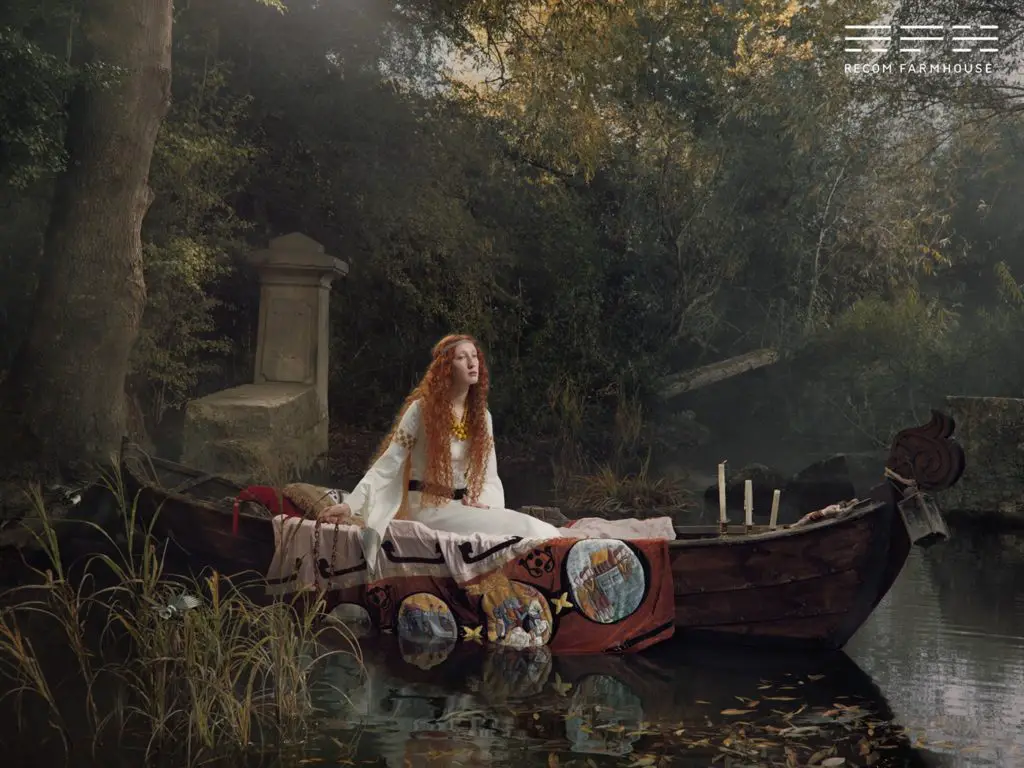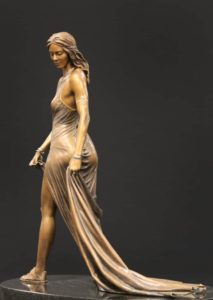Lord Alfred Tennyson’s four-part poem is based on the Arthurian Legend of Elaine of Astolat, who died for that love that surpassed all human understanding. Its recounted version was in the 13th-century Italian book Donna di Scalotta but the poem is an 18th Century work. Lord Tennyson composed the poem in 1842.
The poem is written in four parts and each part contributes to the plot. The plot is the story of a lonely woman who had a curse on her and died for one-sided love.
Part One
 In this Part, stanza one through four is more descriptive in nature. It described the natural and rustic environment of which Lady Elaine lived in. She is said to live in an island castle in a river that flows to Camelot. It is mentioned that the Farmers were oblivious of her existence, but in the morning, reapers could hear her sing a happy song; they nicknamed her ‘the fairy Lady of Shalott.
In this Part, stanza one through four is more descriptive in nature. It described the natural and rustic environment of which Lady Elaine lived in. She is said to live in an island castle in a river that flows to Camelot. It is mentioned that the Farmers were oblivious of her existence, but in the morning, reapers could hear her sing a happy song; they nicknamed her ‘the fairy Lady of Shalott.
And by the moon the reaper weary
Pilling Sheaves in uplands airy,
Listening whispers “Tis the fairy
Lady of Shalott.”
Part Two
Stanzas four through eight lays emphasis on the general life of the Lady. The lady spends most of her time weaving. She heard a whisper that if she took a glance at Camelot that she will be cursed. She does not know what the curse will be but she avoids looking all the same. However, as she weaved she looked at a clear mirror that hung in front of her. The mirror somehow displays the reflection of Camelot and all that happened within the kingdom. She must forever continue viewing images on her loom mirror without looking directly out at the world. The images she saw were referred to as “shadows of the world”, a direct comparison to show that the images she saw were inferior compared to the real thing.
She knows not what the curse maybe,
And so she weaveth steadily
And little other care hath she,
The Lady of Shalott
Part Three
 In this section, we are given a vivid and lengthy description of Sir Lancelot. Generally, his features are that of a very good-looking man. He is portrayed as being bold, had a shield and armor, and looked like a star in the galaxy. His helmet had a feather, his saddle had jewels, and he had black curly hair.
In this section, we are given a vivid and lengthy description of Sir Lancelot. Generally, his features are that of a very good-looking man. He is portrayed as being bold, had a shield and armor, and looked like a star in the galaxy. His helmet had a feather, his saddle had jewels, and he had black curly hair.
All in the blue unclouded weather
Thick-jewell’d shone the saddle-leather,
The helmet and the helmet-feather
Burn’d like one burning flame together,
As he rode down to Camelot.
The other lines of the poem depict the reaction of the Lady on seeing Sir Lancelot. Lady Shallot saw him in the mirror and lost her guard. She was so taken by his appearance that she stopped her work and looked at him, knowing full well what the consequences would be to risk the mysterious curse. The mirror broke, and her web unexplainably falls into the river and floats down to Camelot, on seeing that she knew she had been cursed.
She left the web, she left the room,
She made three paces thro the room
She saw the water-lily bloom,
She saw the helmet and the plume
She look’d down to Camelot
Out flew the web and floated wide;
The mirror crack’d from side to side
The curse is come upon me’, cried
The Lady of Shalott.
Part Four
In this last part, she abandoned her tower for the river banks. The atmosphere was not favorable as it was stormy. She found a boat and scribbled down her name on it around the edges. She entered the boat wearing a white flowing gown and ventured down the river, heading for Camelot. It was unfortunately very cold for she froze to death before she reached Camelot.
The Nobles of Camelot all came out to look at the dead woman in a lovely boat. They read her name written on the boat and kept questioning themselves on who the woman was.
The most ironical part was when Sir Lancelot, whom the Lady craved for bowed down next to her corpse and sorrowfully commented that the Lady has a lovely and pleaded for God to lend her grace.
“Who is his? And what is here?
And in the lighted palace near
Died the sound of royal cheer;
And they crossed themselves for fear,
All knights at Camelot;
But Lancelot mused a little space
He said, “She has a lovely face;
God in his mercy lend her grace,
The Lady of Shalott.”
Setting
Alfred Lord Tennyson’s The Lady of Shalott is one of his most popular poems ever recorded in English Literature. It’s of the medieval period during the times of King Arthur. The poem gave descriptions of pastoral settings. Trees, wind, river, castle, farmers, and river. The appearance must have been rustic in nature.
Themes
Isolation and Deprivation
The theme of Isolation and Loneliness is the dominant theme therein. The poem doesn’t even explain what the lady was doing locked in a castle alone with no form of human communication and interaction. She exists under a spell even without knowing how the curse came about or who cursed her. Tennyson did not provide an explanation based on the origin of the curse. The lady spends her life only weaving and only saw the world through a mirror. There is nothing that sounds more lonely and depriving than that.
One-sided Attraction/Unrequited Love
The downfall and death of the lady were as a result of her attraction to Sir Lancelot. She had her curse under control until she saw his reflection in the mirror and was drawn to look at him directly even though she knew that it might cost her. To top it all, just to see him, she journeyed in very stormy weather and froze to death before she got to see her love.
Supernatural Existence
The mysterious curse on The Lady of Shalott is the plot of the poem. It controlled her life and brought about her death. This notion of the existence of black magic gave the poem a thrilling and disturbing atmosphere.

